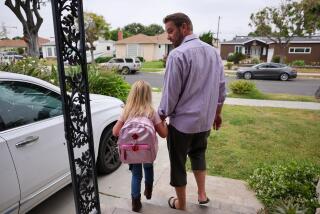Class Size Is a Big Issue for Teachers
In a classroom with 45 seventh-graders, Jeanne Lavieri says she’s being asked to do the near impossible -- teach.
She has 10 more students on average this year than last in each of her art classes. Her lessons are 10 days behind schedule. Half of her students are maintaining Ds and Fs. And she’s had to abandon such hands-on assignments as sculpture.
For the record:
12:00 a.m. Nov. 6, 2002 For The Record
Los Angeles Times Wednesday November 06, 2002 Home Edition Main News Part A Page 2 National Desk 16 inches; 589 words Type of Material: Correction
Class size -- A story in Tuesday’s California section incorrectly listed 42 as the number of students in Meg Schaffer’s most crowded social studies class at Hale Middle School in Woodland Hills. The actual number is 40.
“They already have problems using pens and pencils; I don’t want to see clay flying around the classroom,” Lavieri said recently of her students at Robert Frost Middle School in Granada Hills.
At a time when the benefits of class-size reduction are being challenged, teachers, students and parents in the Los Angeles Unified School District say the quality of education is being compromised by classrooms bulging with as many as 50 students.
A proposal to reverse the increase will be the chief topic of discussion at the Board of Education’s Nov. 12 meeting. If nothing is done soon, schools in West Los Angeles and the west San Fernando Valley may have to consider year-round schedules.
Supt. Roy Romer said the state’s budget deficit is largely to blame for the district’s troubles. The financially squeezed district saved $70 million by increasing class sizes this year, despite efforts by the teachers union to halt the move.
Romer said the district is looking to see where it can reallocate money to relieve the most crowded classrooms.
“It’s a tough economic circumstance we’re in,” he said. “We have to manage our way through this year.”
Critics said a bad situation got worse last spring when the district increased class size by two students in grades four through 12. Overall, the average class size in the district’s middle and high schools has increased by one student compared with last year.
“I’m like a little hamster on a wheel,” said Meg Schaffer, a social studies teacher at Hale Middle School in Woodland Hills, who has as many as 42 students in a class. “I haven’t been this tired in years. Teachers are going to start bailing. I’m not going to kill myself for this district.”
Larger classes are common in West Los Angeles and the West Valley, where schools such as Hale serve predominantly white, middle-class families and are ineligible for extra funding based on race and poverty. As a result, those schools have less discretionary money to hire more teachers.
But crowded classrooms can be found throughout the district, which has about 730,000 students in kindergarten through high school. Virgil Middle School, near Koreatown in Los Angeles, gained 300 students and lost 11 teachers last year. Class size jumped from the mid-30s to the low-40s.
During the first week of school, many students had no desks and had to write on their laps.
“Teachers are doing the best they can, but you can tell the stress level is a little higher,” Assistant Principal Philip Toyotome said.
At Frost, the school year began with more than 50 students in many science classes. Some children sat on overturned trash cans. When a handful of teachers and parents protested, students were moved to other classes to ease the most severely crowded rooms.
Last week, Lavieri had 12 students shifted to other classes. Now, her most crowded period has 43 children.
District officials also say more classrooms are needed and it’s unlikely that conditions will improve unless voters pass a $3.35-billion school construction bond on today’s ballot. “It’s a matter of money and space,” school board President Caprice Young said. “We need both to get this to work.”
Already facing $450 million in budget cuts, the school board has yet to determine how it will pay for more teachers if it chooses to reduce class size. Initiatives throughout the country to limit class size are being reconsidered because of tight budgets and studies that have failed to show lasting achievements by students.
California has spent $8 billion since 1996 to have one teacher for every 20 students in kindergarten through third grade. But a recent study by a consortium of public policy researchers determined that the rush to hire more teachers resulted in too many under-qualified instructors being hired and disappointing academic results.
Jeanne Allen, president of the Center for Education Reform in Washington, D.C., said classes with more than 35 students were too large, and she questioned why the district couldn’t replace administrators with teachers.
Even with smaller class size, she warned that curriculum and teacher qualifications were the most important factors when assessing student achievement.
“Districts like L.A. Unified have bigger problems than class size,” she said.
For many educators, the notion that children learn better when there are fewer classmates is a no-brainer, because teachers can give more individual attention to students.
Many teachers say classes are significantly more difficult to teach once they exceed 35 students because too much time is spent dealing with behavioral issues.
“You can’t separate the students with discipline problems, because there’s nowhere to put them,” said social studies teacher Joe Norton in his trailer classroom of 43 students at Frost. “We’re not getting a lot accomplished, and we have to worry about standardized testing.”
English teacher Erin Scanlon at Grant High School in Van Nuys drew a line at the beginning of the school year. She said that once the 36 seats in her 12th-grade class filled up, she sent all additional students back to their guidance counselors to find new classes.
“I had kids sitting on the floor last year,” she said. “I just can’t have that anymore. When there’s too many kids, you lose them. They don’t pay attention. There is a point when it’s too full.”
More to Read
Sign up for Essential California
The most important California stories and recommendations in your inbox every morning.
You may occasionally receive promotional content from the Los Angeles Times.











